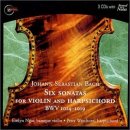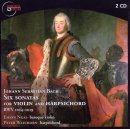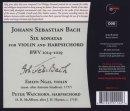|
|
Sonatas for Violin & Harpsichord BWV 1014-1019
Emlyn Ngai (Baroque Violin) & Peter Watchorn (Harpsichord)
Review: Bach Violin and Harpsichord Sonatas
|
H-1 |
J.S. Bach: Six Sonatas for Violin and Harpsichord |

|
|
Sonatas for violin & keyboard, BWV
1014-1019 [13:11, 14:24, 15:46, 17:47, 17:41, 24:38]
Beyond the Notes - Bach as Cappellmeister: Cöthen
1717-1722 [27.39] |
|
Emlyn Ngai (Baroque Violin); Peter
Watchorn (Harpsichord) |
|
Musica Omnia MO-0112 |
Dec 13-14, 2000 [1, 3, 6]
Mar 13-15, 2001 [2, 4, 5] |
2-CD / TT: 103:30 + 27:39 |
|
Recorded at The Sonic Temple, Roslindale, MA, USA.
Review: Peter Watchorn Finds a Home [Satz]
Review: Bach Violin and Harpsichord
Sonatas [McElhearn]
Buy this album at:
2-CD: Amazon.com
| Amazon.co.uk
| Amazon.de
Music Download: Amazon.com |


 |
|
First impressions - sonatas for violin and harpsichord - Ngai and Watchorn |
|
Kirk McElhearn wrote (October 2, 2001):
I have just received review copies of several recordings on the new MusicaOmnia label, run by Peter Watchorn, including his violin and harpsichord sonatas.
www.musicaomnia.com
I thought I would share some first impressions - the sound is indeed unique; the harpsichord is on an equal footing with the violin (this is relatively rare; the Crum/Cummings gamba sonatas featured a similar sound). And, this performance is exciting, energetic, with slightly faster tempi than most recordings I know, it has me tapping my foot.
Very interesting... |
| |
|
Review: Bach Violin and Harpsichord Sonatas |
|
Kirk McElhearn wrote (October 1, 2001):
Bach's Sonatas for Violin and Harpsichord were the first sonatas to take the harpsichord beyond from its role as a simple accompanying instrument and give it a central position in the music. Up until these works, such sonatas would be scored for violin and basso continuo - where the harpsichord and a cello would play “background music” to highlight the violin's central part. Here, however, the harpsichord is specified and given a true instrumental role. Some of the movements in these works are written as trio sonatas, others as fugues, others as three part inventions, and some sound like concertos. The right and left hand parts are not mere filler; they each have their own voices, and these works should be seen as three-part works, rather than two.
This is the approach taken by this recording from the new label Musica Omnia. Harpsichordist Peter Watchorn (one of the principles in the company) sets out with the goal of bringing his instrument to a central position in the soundscape, but, rather than miking it closely to achieve this, uses a very large instrument (a copy of a German harpsichord by Johann Heinrich Harraß) similar to one that Bach may have used.
The effect is brilliant. The clarity of the lines of the harpsichord, added to that of the violin, take this music and give it new life. While the muddy mixes of recordings of these works have often disappointed me, this set has opened my eyes in ways I could not have hoped for. The slow movements take on a new emotion, is in the adagio of the C minor sonata, where the violin merges seamlessly with the triplets of the harpsichord's part. Or the amazing dialogue between the violin and the flowing melody of the harpsichord's right hand part, as the violin accompanies it with its double-stops.
The faster movements contain a level of excitement and energy rarely heard in recordings of these works. The allegro of the E major sonata, with its unique rhythmic energy and, again, the clear presence of the harpsichord's part, is majestic. The vivace, the final movement of the F minor sonata, is wonderful in its quirky sound and rhythm; this three-part fugue gives the harpsichord a very important role, and, at times, the violin follows its lead as the right-hand part takes over.
The two musicians both play excellently. Emlyn Ngai plays a beautiful sounding baroque violin that would be a delight to anyone who fears the often shrill sound of such instruments. Watchorn's harpsichord has a rich, ample sound that gives the lower registers much more body than most harpsichords. Taken together, this is an aural pleasure.
Musica Omnia has come up with an original idea. Each of its recordings contains an additional CD, called Beyond the Notes. This is basically a presentation of the music with spoken text and musical examples. In a way, it can be seen as liner notes with music. While one would not want to listen to this CD many times, it is invaluable in giving the listener a more complete approach to the music. Whether listened to before or after hearing the music, it opens the ears to new insights, in a way that printed liner notes cannot. Musica Omnia deserves kudos for this idea, and it would be wonderful if other labels picked up on it. Here, Peter Watchorn gives an overview of Bach's career in Cöthen-, where these pieces were written, then goes on to discuss each movement of the six sonatas. This gives the listener much more insight into the music, as Watchorn highlights what is unique in each movement.
Another plus on this recording is the performance of a movement that Bach dropped from the first version of this piece. This movement, marked Cantabile, ma un poco adagio, was later reused as a soprano aria in cantata BWV 120. Listening to this haunting movement, one can immediately hear the violin playing obbligato as the soprano part is played by the right hand on the harpsichord. It is a magnificent piece, and a real delight to hear. (This movement is rarely played, but Rachel Podger and Trevor Pinnock also recorded it on their recent set.)
I look forward to hearing more recordings from this new label, especially the projected recordings of Bach’s keyboard works by Peter Watchorn.
This is one of the best recordings available of Bach's Sonatas for Violin and Harpsichord. The performances by both musicians are excellent, the balance between them a revelation, and the addition of the Beyond the Notes disc makes this not only a highly-enjoyable listening experience, but an enlightening one as well. This is an essential disc for any Bach lover.
Contact Details: http://www.musicaomnia.com |
| |
|
Feedback to the Review |
|
Donald Satz wrote (October 1, 2001):
[To Kirk McElhearn] I also find Watchorn's performances the most exuberant I've heard for the Violin & Harpsichord Sonatas. I'm not as impressed with Ngai who sometimes is a little reticent and not sufficiently incisive. As an example, his weeping phrases in the first movement of BWV 1014 could be projected with more emotion and the burst of energy toward the conclusion of the movement is a on the weak side. Also, the fast movements are played slower than the norm, and Ngai has a tendency to go slack now and then. But overall, the set is better than most, and that's all due to Watchorn. The "Beyond the Notes" disc is a great idea and very much adds to the value of the set. |
|
Anne Smith wrote (October 2, 2001):
[To Kirk McElhearn] Beyond the Notes is a brilliant Idea. Thank you for the link to the Musica Omnia site. |
|
Kirk McElhearn wrote (October 2, 2001):
[To Donald Satz] Have you heard his English Suites? I have his two Hänssler recordings, but not the English.
It is interesting to note that he will be recording much of Bach's keyboard works for Musica Omnia. He wrote me the following:
< I will be continuing my Bach recordings for Musica Omnia: the Clavieruebung I and II, Inventions and Sinfonias, and after next year, the Well-Tempered Clavier. These will be recorded either on the same instrument after Harrass, or, in the case of the WTC, on a second and larger instrument (with 16'register), with a pedal-harpsichord underneath.
As you observed with the Bach sonatas, I am reinterested in a very different harpsichord sound from anything currently before the public. A sound, which, I believe, speakes eloquently for itself (and the music)! >
Something to look forward to. |
|
Donald Satz wrote (October 2, 2001):
[To Kirk McElhearn] I have Watchorn's English Suites, and he's very different in those works than in the Toccatas and the Violin & Harpsichord Sonatas. The performances are heavy on legato, rather slow, not very exuberant, and not very deep. I ended up giving the set to my daughter so that it wouldn't be a total loss. |
| |
|
|
|